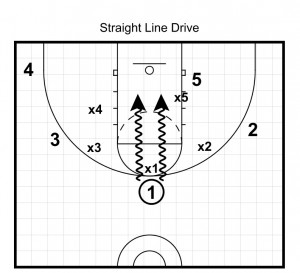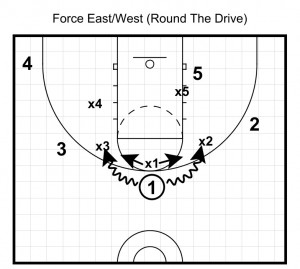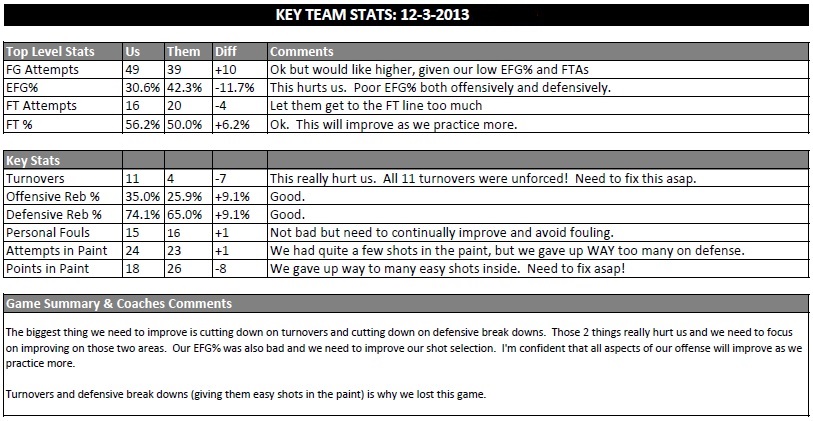We lost our first game of the season. It was against my old team that I coached the last couple years. So it was bitter sweet. I was happy to see the players I worked with last year play really well. But at the same time I wanted to win the game with my new team!!
After the game, I felt like we lost the rebounding battle and that our offensive execution was really bad…
However, after compiling the stats and looking at some game film, I realized I was off base! Based on the numbers and reviewing game film, it’s clear that unforced turnovers and defensive breakdowns were the biggest problem and area we need to improve on. And we actually won the battle on the boards.
This is why I’m a big fan of statistics and game film. They give you an objective evaluation of your performance and what you need to work on. Without stats and game film, I would have been focused on rebounding drills and our offensive execution instead of what we really needed to improve.
Here are the stats and how they are objectively broken down. These are the same stats that I give to our players. This helps them “buy in” to our next practice and our strategy moving forward.
If you’d like, you can view the full PDF and Game Summary that I shared with the players.
It took me about one hour to watch film and collect the stats at the same time. I used our Breakthrough Stats app, which saves me a lot of time because it calculates all the stats for me.
Improving Defense – Straight Line Drives Will Kill Your Defense
As you can see, turnovers and EFG% really hurt us. Our opponents EFG% was too high and ours was low (mainly due to poor shooting).
You can also see that we gave up a high number of shots in the paint. (For me, shots in the paint consist of any shot within 9 feet of the basket.)
We had way too many breakdowns and allowed them to get in the paint too often.
So I watched game video on my computer jumping to each spot where the opponent got the ball in the lane. It only took about 15 minutes using VLC player. I concluded that our “on ball defense” and our “ball screen defense” was the biggest problem.

The next day of practice we focused on those two things. Specifically we talked to players about staying disciplined and “on balance” in their stance. And stopping all STRAIGHT LINE dribble penetration. That killed us!
With straight line drives, our help defenders have no time to provide early help and the help is too late (the ball is already in the lane).
So we focused on our on-ball discipline, good close outs, and making sure the defense is pushed east/west (minimize north/south drives). 
If we can force the defense to take a rounded drive to the basket, our help defense can seal seams and get them stopped early.
Cutting Down on Turnovers
Looking at the report in Breakthrough Stats I can see that we had 7 bad passes, 3 travels, and 1 other turnover.
To solve the problem we did the following in practice…
1) Read the Defense When it’s Loaded Up
We talked to the players about reading the defense. They need to see if the defense is set and loaded up. If the defense is in good help position and loaded up, we need ball reversals and player movement. Then once we get some movement and the defense softens up, look to attack the gaps.
Our guys just weren’t looking to see if we had the advantage and attacked when nothing was there. This resulted in bad shots and some turnovers. I like the aggression. We just need to be smarter about it.
We went through a few situations on the court and practiced our motion.
2) No dribble drills
Next we practice some “no dribble drills” and emphasize a few concepts…
The drill is simple and one of the best for cutting down on “bad passes”. You can play 3on3, 4on4, or 5on5. It can also be full court or half court. But I usually like to play full court.
You play a game to 3 points or for a set time (5-10 minutes). Players are NOT allowed to dribble. Each time you turn the ball over, players get 3 burpees for the end of practice. Keep track of the burpees they accumulate.
Make sure you emphasize the following…
– LOOK before you pass! You have to see the defense.
– Meet your pass!
– Catch and face the basket in triple threat.
Now players will also have to use their pivot, get open, maintain spacing, and pass “away” from the defense. But if you fix those three things above, you will cut down on most of your bad passes.
After every bad pass I blow the whistle and yell.. “Look before you pass. Meet your pass. Catch and face in triple threat!”
It usually takes a week or two. But players will figure it out and this is the best drill I know for cutting down on bad passes. It also improves your off the ball movement, spacing, and footwork.

I like your no dribble drill Coach. But, playing devil’s advocate here, do you have player’s sometimes not dribble in the games because of the drill? I’m talking about the more inexperienced JV or middle school type….and, if so, what do you do to correct them?
Coach H – Good question. With the high school kids, it’s definitely not a problem. In my experience they all over dribble (catch and dribble… catch and dribble) when they come into the program. I have heard many other coaches say the same thing.
At the youth level, it can be a little different. I have personally run quite a few “no dribble” type of drills with 2nd and 3rd graders. I have not coached a team at the middle school level, so I can’t speak for them. With the 2nd/3rd graders, they will forget you can dribble in a game. But usually after a quick reminder or two… “hey… you can dribble”, it clears up. Usually they say… “oh, we can dribble??”.
So long story short, it’s not a problem and I do run lots of no dribble drills with the young kids. Some coaches have told me that they really like how our team passes the ball. Most youth teams just look to dribble and there is very little passing. Maybe I’m biased, but I think our 3rd grade team does a decent job for their age level…. if there is an open lane, they dribble drive to the basket. If nothing is there, they usually pass to the open player.
I’ve also been noticing poor spacing, bad passes and loaded offense on strong side. I know we have too many unforced turnovers because the players don’t relate drills to game time decisions. I can only run half court practices. How do I rectify this? (8/9 team and 10/11 team)
Coach Shaw – For bad passes, here’s what has worked for me…. First I share our stats with players and make sure they buy in. They all understand the importance of ball security and how it impacts the game. This was made clear in our first team meeting. http://jeffhaefner.com/coach/excited-had-our-first-mandatory-meeting-with-the-players-off-to-good-start/
Next we continue emphasizing the importance of taking care of the ball. We generally have a few players that continually make the same poor passes and decisions. So I just talk with them individually and try to show them situations of poor passes (sometimes using film). Then try to show them examples of better decisions. It’s essentially getting them to realize that making the easy pass is better and do NOT throw the tough thread the needle passes.
Last, we do passing drills every day. Here are the drills we do. I don’t know if they will work with half a gym (do you have the side baskets to go full court?).
http://jeffhaefner.com/coach/my-favorite-passing-drills-how-to-cut-down-on-bad-passes-and-turnovers/
I have found the decision making drills and in particular the “scoring system” help us a ton. Kids start coaching themselves because they want to win. I hear them telling each other to jump stop. Look before you pass, etc, etc. The rules kinda solve the problem. It takes a little while but I have found that these daily drills do translate into games.
For spacing, it depends on your offense. What offense do you run? We use “spots” to help players with spacing.
How do you score VPS?
The VPS (Value Point Score) came from Danny Miles. He goes into detail about it and other keys to his program in this DVD. http://www.breakthroughbasketball.com/pr/value-point-system.html
The formula is
Points + Rebounds + 2x(Assists) + 2x(Recoveries)
————————————————————–
2x(Field Goals Missed) + Free Throws Missed + 2x(Fouls) + 2x(Turnovers)
Recoveries include steals, blocks and charges. You can also include forced jump balls too.
What does it mean “meet your pass – ” I am a foreigner, that´s why I can´t fully understand that phrase.
“Meet Your Pass” means… when someone passes the ball to you, take a step toward the ball. This shortens the distance ball has to travel, so the defense has less time to steal the pass.
To be honest, this is what I actually thought in the first place. Thank You. Your site is very useful, keep up the good work. Greetings from Estonia:)
Coach, what would be considered the baseline or average for the VPS? What would be the ideal number for a high school kid? Just by looking at it, it looks like anything above .8 would be pretty good. Thanks for going into more detail on this subject
For the most part we compare to other players on the team for that season because it partially depends on the competition you are playing. With that said having a baseline is nice and players do like to compare themselves to players in previous years. Last year our 9th graders had an average VPS score of 1.03. The best player averaged 1.63. This is quite good and we went undefeated last year. Last year our 10th graders averaged 1.07. We won 15 games and lost 5 against really good competition.
This year is a little different. After 7 games our 10th graders are averaging .8. We won 3 and lost 4. I have not added our last two games which we lost. We are struggling this year. If our VPS was closer to 1, we’d be winning most of our games.
To put in perspective, Magic Johnson had a career VPS of 2.07. Larry Bird 1.67. Charles Barkley 1.67. My best 9th grader scored almost as high as Bird and Barkley. He’s obviously nowhere in the ballpark of those guys. So as I mentioned earlier, it does depend on your competition.
Hope this helps.
“So I watched game video on my computer jumping to each spot where the opponent got the ball in the lane. It only took about 15 minutes using VLC player” – Coach Jeff, can you give a brief explanation of how you “jumped” ? does this program allow tagging of video for repeat searches? thanks.
Brad – I usually use VLC keyboard shortcuts to jump around:
Shift+Arrow Left/Arrow Right
Alt+Arrow Left/Arrow Right
http://www.shortcutworld.com/en/win/VLC-Media-Player.html
I skip our possessions, free throws, deadtime, etc. and pretty quickly get to where I see them driving into the lane.
I don’t know if there is a way to tag video. I do know Krossover does tagging and gives you quite a few filters. Not sure if there’s an exact filter for this situation but they have quite a few that come in really handy. I have used Krossover for about 4 of our games and really like it so far.
So I have purchased the VPS packet from breakthrough. We love the idea for the program. We are just stuck on one point. How does the system take into effect players that are in at the end of the game. I understand that there should not be garbage time, but I don’t think that the system is totally fair in this respect. we have one player that has a VPS score of 1.88 but has only shot 7 shots all season. He is not a strong bball player, and therefore the last few minutes of the game. Often he does not do much besides getting into a game and taking a shot, so he has hit 4 out of 7 shots, and has a higher vps then the one player we have on our team that is going to all-stars with a 1.07? There is no way to factor in the ability to run plays or play good defense if the player does not contribute to that on the floor. No action does not hurt your VPS score. Does you have this issue?
I think everyone has that problem. There are several ways to solve it. The solution you choose depends on the age of the players and your preference.
Option 1 – Give a score of “NA” or leave it blank, unless there are at least X positive stats and X negative stats for the player. If it’s just one game, I might require at least 5 positive stats and 2 negative. All our players know that this score varies quite a bit from game to game. If it’s a multi-game or season long score, I might require at least 10 positive stats and 10 negative stats to register a score.
Option 2 – Give a score of “NA” or leave it blank, unless there are at least X minutes of playing time recorded. For a single game I might require at least 8 minutes of time. For multiple games, I might require at least 50 minutes.
Option 3 – Do nothing. I just show the scores regardless and the VPS scores have still given us a huge benefit. All the players understand that if you only play a few minutes and get a high score, it doesn’t mean anything.
As Coach Miles pointed out in the DVD, you need to get about 5 games or 50 plus minutes registered before the rating becomes statistically significant.
You said, “So we focused on our on-ball discipline, good close outs, and making sure the defense is pushed east/west (minimize north/south drives).” How did you do this? Any drills to work on this?
We played shell drill, 5v5 half court, and 5v5 full court. Used the word “freeze” often and made sure we never gave up straight line drives… just emphasized it the entire practice.
We also ran a simple close out drill. Any close out drill will work fine but this is what we used.
https://www.breakthroughbasketball.com/defense/star-closeout-drill.html